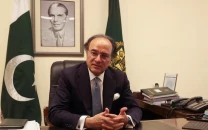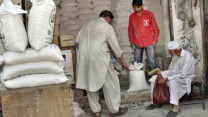SBP cuts discount rate to 8%
State Bank cites downward trajectory in inflation and an improving economy for cut in discount rate

PHOTO: EXPRESS
The central bank has cut the key interest rate in the economy by a cumulative 2% since last November partly because of a sharp decline in inflation.
The discount rate is the interest rate at which commercial banks are allowed to borrow from the central bank’s discount window on an overnight basis. Central banks use this monetary policy tool to control money supply in the economy in order to achieve price stability and economic growth targets.
“Headline Consumer Price Index inflation continues to follow a downward trajectory and is expected to be well below the annual target of 8%,” the SBP said in its monetary policy announcement, adding that it now projects the average CPI inflation for 2014-15 to be in the range of 4%-5%. Low prices in the global oil market led to year-on-year CPI inflation of 3.2% in February, which is the lowest reading in the last 11 years.
Out of 25 research houses surveyed recently by Business Recorder Research, as many as 20 predicted the SBP would cut the discount rate by 0.5%. Consistent reduction in the cut‐off yields of Pakistan Investment Bonds and Market Treasury Bills since February also indicated that a decrease in the interest rate was in the offing.
Speaking to The Express Tribune, Taurus Securities Head of Research Zeeshan Afzal said the realignment of the monetary policy was expected given the existence of the record-high real interest rate, which is defined as the prevailing interest rate minus inflation in the economy.
The approximate difference between the return on one‐year government paper and the CPI stood over 5% before the latest rate cut. This means businesses had to pay an exceedingly high cost of funds because the average spread between the two rates has been only 1.7% since July 2009, Afzal noted.
The large-scale manufacturing sector, which grew 2.2% in the first seven months of 2014-15, is expected to gain traction due to the rate cut and low prices of raw materials, the SBP said. However, representatives of the industry believe the latest rate cut of 50 basis points is insufficient.
“We had demanded a rate cut of at least 100 basis points. Industrial growth cannot be achieved unless credit availability is made easy. Along with cutting the interest rate, the SBP should also ensure that banks increase their lending to the small and medium-size businesses, which are the real engines of economic growth,” Karachi Chamber of Commerce and Industry (KCCI) Iftikhar Ahmed Vohra told The Express Tribune.
Painting an overall rosy picture, the SBP said an increasing number of economic indicators in the current fiscal year have moved in a favourable direction. “The government’s efforts to contain the fiscal deficit have been on track in the first half of 2014-15 despite slightly slower growth in revenue collection,” it said.
SBP’s optimism is in spite of recent news reports that suggest the government is resorting to ‘creative accounting’ in order to contain its budget deficit to 4.9% of the GDP. The government plans to delay some expenditure obligations besides seeking an additional Rs20 billion from profits of the SBP in order to control its budget deficit, according to news reports.
The monetary policy statement said GDP growth in the current fiscal year is expected to be higher than that of the last year when the economy expanded by 4.1%. However, the SBP stopped short of mentioning that the GDP growth rate that the government projected at the beginning of the current fiscal year is 5.1%. Recent reports suggest the government is likely to miss the 5.1% target for GDP growth and now expects it to hover around 4.5%.
Referring to the stability in foreign exchange market and an increase in foreign exchange reserves, the SBP said the external sector outlook remains stable.
While the SBP appears to be comfortable with the rebound in the local currency, most analysts believe that the newfound strength of the rupee has hurt Pakistan’s export competitiveness. According to Afzal, the pound, the yen and the euro have already depreciated by 1.2%, 2% and 6.5% against the rupee, respectively, since January 1.
“With strong workers’ remittances and declining import growth, current account deficit has shrunk in Jul-Feb compared to the same period last year. The improvement is in spite of subdued exports performance,” the SBP said.



















COMMENTS
Comments are moderated and generally will be posted if they are on-topic and not abusive.
For more information, please see our Comments FAQ